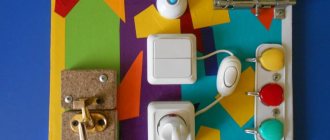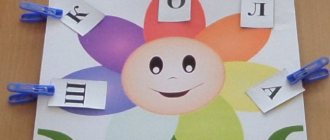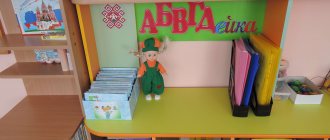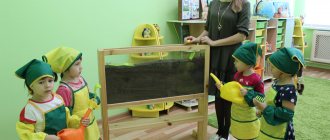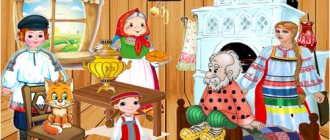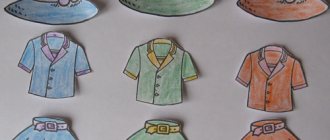Didactic games for speech development (do it yourself).
Content
Didactic game "Baron Munchausen"
Goal: to develop the skill of forming nouns with diminutive suffixes.
The manual is a map measuring 30x20 cm with an image of Baron Munchausen flying in the clouds on a cannonball, and a set of subject pictures measuring 10x10 cm. Speech therapist.
Children, look at the map with the image of Baron Munchausen. The brave baron was known to fly on a cannonball high in the sky. From above everything seemed very small to him. He looked at everything from top to bottom and was surprised: “How tiny everything is from here!” Little houses, trees, people.”
Now I will show pictures, and you will say what is drawn on them, and then you will call them what Munchausen would have said about them if he had seen them from above.
For example, a house.
What will Munchausen say about him?
Children. House. If there is difficulty, the speech therapist provides assistance to children in the form of guiding questions. Presenting the picture, the speech therapist asks: “What is this?” Children answer (monosyllabic answers are acceptable). Then the speech therapist attaches the picture to the Munchausen card. Speech therapist. What will Baron Munchausen say when he sees this from above as a little boy? (Conjugate and reflected pronunciation is used.)
Based on the plot pictures (shown below 10x15), you can compose descriptive stories using nouns with diminutive suffixes. For example:
Where did Baron Munchausen fly? What did he see? Or who did you see?
GAMES WITH CLOTHESPENS “Who eats what?”
The main purpose of using clothespins in play is to develop fine finger movements, which has a beneficial effect on the speech area of the brain.
Games with clothespins develop not only fine motor skills, but also develop imagination and the communicative function of speech, strengthen sensory skills and spatial concepts.
We introduce the baby to clothespins, show and tell where the mother uses them in everyday life, show how the clothespin can open and close its “mouth”, let the child independently help the clothespin open and close its “mouth”, if it is difficult for the baby, help him and tell him what to do You need to squeeze your fingers harder. Then we invite the child to play with clothespins. To get started, you can play simple games.
Equipment: circle, 12 pictures of food; 12 pictures of animals on clothespins, poems about animals.
DEVELOPING CREATIVE IMAGINATION IN GAMES WITH CLOTHESPENS
Goal: development of fine motor skills, attention, memory, speech practice.
For the game, I cut out several figures from colored cardboard. We will then attach clothespins of different colors to these figures. During the game, you can teach children both colors and poems about these objects.
SUN
(We attach clothespins of the same color to the yellow circle figure - these are the rays of the sun)
The sun rises early in the morning. Pulls rays - gives us warmth
.
CLOUD AND RAIN
(We attach clothespins of the same color to the figure of a cloud of blue or cyan color - this is rain)
A cloud walked across the sky - Lost all the raindrops.
Herringbone
(We attach clothespins of the same color to a green triangular figure - these are spruce branches)
Our Christmas tree suddenly became sad and lowered its spruce paws.
VEGETABLES - BEET, CARROTS, TURNIP
(We attach green clothespins to the red beet shape - these are the tops)
We collected the harvest and tore off all the tops. We attach the leaves - We will immediately learn about the vegetables.
HEDGEHOG
Hedgehog, hedgehog, where were you walking? Where did you lose the thorns? Run to us quickly, hedgehog. We will help you now.
“What’s missing?” with these clothespins.
For example: A flower has petals, a hare has ears and a tail, a carrot has tops; then we ask the child: how many petals does the flower have? What color are they?
Didactic game "Postman".
Goal: to develop the skill of using nouns in the genitive, dative and nominative cases. Develop children's coherent speech.
The manual is a cut-out image of a postman with a bag and an envelope in his hands, a set of postcards, images of animals and birds (the number of cards and lexical material are determined by the speech therapist depending on the level of speech development of the children).
Cards - imitation of envelopes with the image of an animal or bird, mean the addressee (the one to whom
the letter is intended) or the addressee (the one
from whom
the letter is).
A letter to a cow
from
a chicken.
Letter
to the fox
from
the mouse.
A letter
to a butterfly
from a snail.
Speech therapist. The forest postman asked us to help him deliver letters. You will take the letter, look at the pictures and say who it is to and from whom. If there is difficulty, the speech therapist helps with guiding questions. The game continues until the postman delivers all the “letters” and postcards.
You can make sentences and stories using postcards;
Ask your child leading questions about the topic of the postcard. For example: Who is depicted on it? Who are the flowers for? What holiday will we celebrate soon? And so on. infourok.ru
Board games for speech development for preschoolers
Board games for speech development for preschoolers: modern, exciting board-printed games and cards for activities with children in kindergarten, children's center and in the family.
Board games are always loved by children, interesting to them, and useful. There are many board speech games - various “walkers”, dominoes, lotto, and various sound tracks, cubes with symbols. These are games for the development of vocabulary, coherent speech, phonemic perception, grammatical structure of a child’s speech, imagination and thinking, attention and perception.
Modern board speech games for children are very different from their predecessors in their entertaining form of presenting material, interactivity, versatility, and quality of printing and cardboard. They combine clearly thought-out game content, a convenient card format, and print quality. The cards are made from special durable paper that can withstand the pressure of curious children's hands and is resistant to abrasion. The cards are dense and at the same time light, do not tear, do not get dirty, they are comfortable to hold in your hands, they have a child-safe shape without sharp corners.
In this article I want to introduce you to new products - modern board speech games for preschoolers, developed by specialist teachers and published by Mersibo.
Section 1. Board games for the development of phonemic awareness of a preschool child
Speech game 1. Star from the sky
Children's age: “Star from the Sky” is a fun game to develop speech for children aged 4 years and older.
Why this game is useful: The game develops children's phonemic hearing, teaches them to distinguish between sounds s and z, helps automate the correct pronunciation of these sounds in words, teaches them to compose sentences with given words, develops memory, and teaches them to describe pictures.
Where can this game be used: The game can be used in developmental classes with children at home, in a children's center, with teachers in a kindergarten, as well as in classes with a speech pathologist.
How many children can play the game: from one to four children at a time.
The set for the game includes: laces (4 laces and 4 fasteners) and cards with stars (32 pictures - stars with words with the sounds S and Z, made of very thick high-quality cardboard).
How to play the game: three variants of the board game “Star from the Sky”
Option 1.
- Players determine which of them will catch stars with the sound s, and who will catch stars with the sound z.
- Next, one by one, players take a star, turn it over and name the picture. If the picture is named correctly, then the player strings it on his string. He caught a star from the sky!
- The game ends when the children have all the stars.
Option 2.
- The presenter takes the star and does not show the children his picture. He describes what is drawn in his picture. Children guess. If the child guesses right, he takes this star for himself and strings it on his cord.
- Whoever collected the most stars (or whose team guessed more - collected the stars) won the game today.
Option 3.
- Children make up a sentence with the word shown in the picture of the star. If the child's proposal is accepted by the players, then he strings the star on a cord. If it is not accepted, then he comes up with another proposal or clarifies the first one.
- At the end of the game, players look at each other's stars and remember who named what sentence.
Speech game 2. Ram or roach
In this game we will go fishing with the children and catch fish. But our fish will be unusual. On the back of the fish cards there are pictures of words with the sounds R or L.
The game set includes: 32 fish with pictures for the sound R or sound L, 4 laces and 4 clamps.
How many players can play the game at the same time: from 1 to 4 children.
This game is built on the same principle as the game “Star from the Sky”, but is aimed at reinforcing the correct pronunciation of the sounds R and L in words and phrases. It develops the child’s memory, attention, phonemic hearing, and the ability to compose sentences.
The game options are the same as in the previous board game for children:
Option 1. Children catch fish with their strings. Someone catches “ram” and other pictures - fish with the sound R, and names what is drawn on the fish he caught. And someone catches “roach” and other pictures with the sound L. The game ends when all the fish are caught. Which fisherman had luck fishing today? ?
Option 2. The game leader (at first an adult) catches a fish, but does not show the picture to the children. He describes it, and the children guess what kind of picture the fish brought him. Whoever guessed right takes this fish and strings it on his own string. The fisherman who has the most “catch” in this board game wins.
Option 3. Players make sentences with words. And at the end of the game they remember who came up with what proposal.
Section 2. Cards on articulation gymnastics for preschool children
Set “Articulation gymnastics in pictures and rhymes” for classes with children
The conveniently sized set (fits in the palm of an adult) includes 27 high-quality cards.
How the cards are printed:
- On one side of the card there is a picture for the child (pancake, cook, etc.).
- On the other side of each card is the name of the exercise, its description and a rhyme.
The set includes 27 basic speech therapy articulation exercises: snake, shovel, swing, turkey, fence, breeze, drum, smile, hamster and others.
The cards can be used by speech therapists, educators, tutors and nannies, teachers of children's centers and parents.
The cards are made on very high quality thick paper and will withstand many years of use. They do not take up much space and are convenient to store or take with you.
Section 3. Speech therapy game tasks in pictures
1. Taratorki on the hill: cards with speech therapy tasks in pictures for children
The set includes 27 tasks in pictures for children to automate the correct pronunciation of the sound R. To consolidate the correct pronunciation of the sound in a child’s speech, it is necessary to repeat words and phrases with this sound multiple times. With interesting tasks that force the child not to answer mechanically, but to think, compare, choose, it is much more interesting to develop speech!
This set can be used by speech therapists, kindergarten teachers, and children's center teachers. Parents can also work with him on assignments from a speech therapist.
The set includes a wide variety of speech activities for children. For example:
- pronounce the words tenderly, loudly - quietly,
- find an error in a sentence and correct it,
- replace the first sound in a word like this. to make a new word,
- repeat the tongue twister and the tongue twister,
- name which animal has horns, what a pizza chef needs, name musical instruments,
- say the opposite (antonyms),
- name what is drawn and determine the place of the sound R in these words,
- perform a movement
- count the objects in the picture.
3.2. Squirrels - balabolki: cards with speech therapy tasks in pictures for children
This is a set of the same series, but dedicated to words with the sound L. It consists of 27 cards with different tasks with words that contain the sound L. For example:
- name the words and determine what is superfluous here,
- answer the question based on the picture - “Who does the husky bark at?” “Who won’t you meet in the fairy tale Kolobok?”, “Who is on the bench, and who is under the bench?”
- pronounce a tongue twister and tongue twister,
- name the halves
- show movements,
- say by example
- find the same syllable in a chain of words and many other tasks.
Section 4. Speech therapy sets of cards for games and activities with preschoolers
These cards are intended for use by teachers to examine and develop the speech of preschool children.
1. Listen, name: a set of cards in pictures for the examination and development of a child’s phonemic hearing
The set includes 27 cards for examining phonemic hearing, developing auditory attention, analyzing the sound composition of words, and developing phonemic perception.
Examples of cards: mouse - bear, soup - tooth, husky - shop, pipe - booth, knife - nose, beetle - bough, fishing rod - duck and others.
2. What comes first: compiling a story based on a series of plot pictures
The set for the development of coherent speech in children includes 27 pictures (9 series of pictures). The child looks at the pictures, puts them in the correct sequence and makes up a story.
The kit can be used in examining the speech of children, in individual lessons for a child with a speech therapist, in playful speech exercises with a series of pictures.
3. Runs and lies: a set of pictures to activate the child’s verbal dictionary
This is a set of pictures to activate the verb dictionary. It is intended for individual lessons of a speech therapist - defectologist with a child with hearing and speech impairments of varying degrees. The set can also be used by kindergarten teachers and children's center teachers for individual lessons with children.
The set includes 27 pictures. This:
- pairs of pictures: girl sings - bird sings, mother sits - dog sits, duck swims - man swims, boy washes himself - cat washes himself, kangaroo jumps - girl jumps, boy plays - kitten plays, boy sleeps - cat sleeps, boy runs - cheetah runs .
- pictures with actions characteristic only of a person: mom waters flowers, a girl combs her hair, mom vacuums, dad writes, and others.
Where are these board games and cards for children's speech development "Mersibo" sold?
You can purchase all these board games and cards on the website of the game developers - the Mersibo team.
More board speech games for preschool children
Interesting and very original and high-quality board speech games are also produced by the Rebus Center for Education and Creative Development (the head of the center is Tatyana Barchan). In the article “Games for Speech Development” you will find three more board games developed by Tatyana for the development of speech in preschool children: “Not Just a Cat’s House”, “Where is the Mouse”, “Where is My Tail”.
You will learn how to make board speech games for children with your own hands from the articles on the “Native Path” website:
— Do-it-yourself speech board game “Didactic Box”.
— Speech board game with cubes “Make a sentence” with your own hands.
— Do-it-yourself speech board game “Tricky Classics”
Get a NEW FREE AUDIO COURSE WITH GAME APPLICATION
“Speech development from 0 to 7 years: what is important to know and what to do. Cheat sheet for parents"
Click on the link or course cover below to subscribe for free
The author of the course is Valasina Asya, candidate of pedagogical sciences, author of the website “Native Path”
rodnaya-tropinka.ru
Game "Didactic box"
Game “Didactic Box” - do it yourself: familiarization with colors, speech development, development of fine motor skills, familiarization with the seasons.
Author of the game
– teacher-defectologist Olga Makhaneva.
Olga works with children from two to ten years old. This game received the “Best Speech Game” award at our do-it-yourself educational games competition at the Internet Workshop of educational games “Through the game - to success!” — 2015. This is not Olga’s first game to receive prizes in the competition, because Olga has been participating in our project for the third year and always shares her ideas with other teachers and parents.
Description of the game “Didactic Box”
The game “Didactic Box” is made from a round tin box
from under candy or cookies. The bottom and lid of the box are covered from the inside with multi-colored felt in sectors. The side edge of the lid is covered with magnetic tape.
Bottom of the teaching box
consists of sectors of four primary colors - blue (winter), green (spring), red (summer), yellow (spring).
Lid of teaching box
the inside is divided into eight sectors in accordance with the colors of the rainbow plus white.
The outside cover of the box is divided into 4 sectors and
glued with white, gray, orange, brown felt. These are the main colors of animal fur, which can be called: white bunny, orange fox, brown bear, gray wolf.
Side part of the lid of the teaching box
taped with magnetic tape. You can attach flat black and white images of animals or birds to it, naming their color and nuances of shades (brown, red).
Now add the cubes:
download patterns of cubes for playing with the educational box for free here
- on the first cube - images of forest animals (on one side - one animal),
- on the second die - the actions of animals (how they can move),
- on the third cube - the color of the animals (white, gray, red, brown, gray-white, white-red, etc.),
- on the fourth die there are numbers or dots.
You will find an example of a game with cubes in the article “Speech game “Make a sentence”.
How to use the game "Didactic Box"
The game can be used to introduce children to colors, seasons, geometric shapes, develop fine motor skills (exercises using clothespins), and develop the child’s speech.
Options for tasks with the game:
- choose a pair (attach red clothespins to the red sector, yellow ones to the yellow one, and so on in accordance with the color of the sectors),
- name the color of the animals - game with a box lid (speech grammar game for mastering the agreement of adjectives and nouns: gray bunny, gray mouse, gray cats). We place the animal figurine on the side magnetic panel of the lid in the corresponding color sector and name the animal and its color,
- seasons (arrange pictures with signs of seasons into sectors and explain your choice - why the child thinks that the picture shows spring, and not summer or autumn),
- development of fine motor skills: a) attaching clothespins of different colors in accordance with the color of the sectors, or b) clothespins with figures on the side of the box. (For example, in the game “find your house”. If the bow of a toy is blue, then its house is blue. And the animal figurine needs to be attached to the blue sector. If it is red, then it is red, etc.),
— classification. The task is to arrange geometric figures of different shapes, sizes, thicknesses by color into sectors in a box (the child needs to highlight the leading feature - color, without paying attention to the different thicknesses of the figures and their size and shape)
- collect the months of the year (we name the months of each season, if the child correctly named the month, then he attaches a clothespin to the corresponding sector).
- find neighbors (name the neighbors of the month - for example, the neighbors of January are December and February).
The box can also be used as a little house for director's games with children.
We wish you interesting games!
You will find more ideas for interesting speech games with children in the articles on the site:
— Modern board games for the development of speech in preschoolers.
— Speech games with words
— Fun speech games for children: games with words in poems and tasks.
— Board speech game “Tricky Classics”: how to make and how to play, game options.
— For kids about the history of the Russian language: a filmstrip for children about the expressions “to kick the bucket”, “to the full extent of Ivanovo”, “to start from the red line” and others.
— 10 games to prevent grammatical errors in children’s speech.
— Prepositions in poems, pictures, games and tasks for children.
Get a NEW FREE AUDIO COURSE WITH GAME APPLICATION
“Speech development from 0 to 7 years: what is important to know and what to do. Cheat sheet for parents"
Click on the link or course cover below to subscribe for free
The author of the course is Valasina Asya, candidate of pedagogical sciences, author of the website “Native Path”
rodnaya-tropinka.ru
Developmental mat
The fabric of the rug should be bright, but at the same time natural. It is advisable to use different types of fabrics - silk, corduroy, pile, felt, so that the child would be interested in exploring it. Make inserts out of them.
The base can be made of foam rubber or felt. If you have an old baby blanket at home, use that as a base. Sew a duvet cover that you can remove and wash at any time.
Design your rug the way your imagination desires; you can do it based on a fairy tale. Sew buttons and other protruding items onto the surface. These can also be small toys, ribbons, zippers that fasten and stretch. The child will want to spend a lot of time on such a rug, exploring its space.
Didactic games on “Speech Development”
Photo report
Didactic games for speech development
for children of senior preschool age
Completed by: Suzdaleva Yu.O
Makhmetova A.T.
The most difficult and biggest problem in teaching preschool children is to teach them to speak coherently and expressively. The main goal of educators is to help the child master this wonderful gift.
When working with children, teachers set the following tasks for speech development: enriching the vocabulary of preschoolers and activating vocabulary, developing the grammatical structure of speech, forming a sound culture of speech, forming and developing coherent speech.
A didactic game is a gaming method and form of teaching preschoolers. Thanks to didactic play, children better assimilate initial ideas about the surrounding reality, develop verbal communication skills, and the ability to correctly express their thoughts.
Didactic game is a multifaceted phenomenon, which can be a teaching method, a form of teaching. Made by the hands of teachers, they allow the child to reveal his potential using the body’s analyzers (auditory, visual, tactile) and direct the educational process to achieve positive results.
Preschool educational institutions specialists who practice educational activities often resort to making educational toys with their own hands or together with group pupils from various waste materials. Self-production allows you to diversify the presentation of program material, taking into account the capabilities of the children's contingent.
We have produced the following educational games:
Didactic game “Collect a letter”
Target:
Strengthen children’s ability to form a whole from parts; attach a graphic image of letters; development of imagination, imaginative thinking, fine motor skills of the hand; continue to learn to concentrate; help develop observation skills.
Rules of the game
The child must complete the puzzle and get the hidden letter. Remember what it looks like and is called. To reinforce, name words that begin with this letter. They are drawn in every element.
Didactic game
“Learning letters”
Target
: teach children to name the letters of the alphabet; develop memory and thinking.
Rules of the game
: the child needs to choose the corresponding picture for each letter.
Didactic game
«"My", "My", "Mine"»
Target:
Teaching children to agree nouns with pronouns
my, mine, mine
; focusing on the endings of words.
Rules of the game:
Children are asked to arrange the pictures into an apple called “Mine”, “Mine”, “Mine”.
Didactic game for speech development
“Name it in one word”
Target
: promote the development of logical thinking, memory, speech, the ability to generalize, justify.
Rules of the game
: We play with one or more children. Children are asked to identify a common feature that covers the entire set of objects of observation, and to name the objects in one word.
infourok.ru
Volume book
To make a book, you will need a little perseverance, as you will have to make small parts, but the result is worth it. Arm yourself with all the necessary materials: needles, scissors, threads, fabric, padding polyester or foam rubber, various decorations - beads, buttons, beads and other things.
First sew the book page from two rectangular pieces in the same way as you sewed a blanket. You can put padding polyester or foam rubber inside it. Sew the applique onto the page, according to the plot of the fairy tale. This needs to be done on both sides. You can take the plot of any children's fairy tale: The Fox and the Rooster, Kolobok, The Ryaba Hen or come up with your own. Along with the appliqués, stick buttons, laces, ribbons, bells, and small toys onto the page; this will stimulate the child’s research activity. After all the pages are sewn and decorated, they will need to be sewn together. You can do this using curtain rings or satin ribbon, threading it through the eyelets.
Didactic games for speech development for all groups of preschoolers
Speech is a means of exchanging information with the outside world. Therefore, in school and preschool institutions, much attention is paid to the development of coherent speech. Didactic games for speech development are a way to form correct speech, pronunciation, develop motor skills and expand vocabulary.
Didactic games are useful because they develop speech functions in a playful way, without straining children. The card index of games for preschoolers includes methods used to develop speech, thinking and even memory.
For children, play is the main means of learning, which is systematically used by educators in preschool institutions and parents. The desire of preschoolers to play is constantly manifested; an experienced teacher will direct it in the right direction so that the child develops in a playful way. And correct and complete development is possible only with the right approach to setting up exercises.
The golden rule of Comenius didactics
The didactic rule developed by scientist and psychologist Ya.A. Komensky, speaks of the most important principle of clarity, without which learning will cease to be effective. The principle of visualization states that learning is expedient if the use of the senses is connected to it.
- The rule says that it is important to approach the formation of children’s cognitive processes from a practical point of view. The guys will do experiments, observe, make mistakes, and draw their own conclusions. Only through such methods will the process of acquiring knowledge become effective.
Games for the younger group
It’s not difficult to come up with exercises and create props for them with your own hands; the material can be found in every room. Kids are just beginning to understand the world around them, help them better understand speech, learn to formulate thoughts and answer questions. Play these games:
- Print out a picture of the room. Make your own or print and cut out pictures of animals: cats, dogs, parrots, fish. Say that animals don't remember where they belong. Ask your child to place the cat ON the sofa, the dog UNDER the table, the parrot ABOVE the sofa, and the fish IN the aquarium. The game is designed to teach prepositions. During this process, use your voice to highlight prepositions.
- Give your child a word. For example, "cup". Ask them to name the same object, only small. If he doesn’t guess correctly, say it’s a “cup.” Practice with multiple items in one game.
- Tell your child: “What is green around us?” Have him list the green items. Change the formulation of the question. Options: Which objects will I say are red? Do you know which objects are yellow?
The games are suitable for the first and second younger groups. Remember that children are not yet able to concentrate on one activity for a long time, so do not study with them for more than 20 minutes a day, unless the baby asks for more.
Games for the middle group
Children in the middle group of preschool educational institutions already know how to formulate some thoughts and have a small vocabulary. To influence the development of coherent speech, vocabulary and thinking of preschoolers, play didactic games with them:
- Ask your child: “What rides?” List the objects: train, plane, carousel, car, carriage. Ask your child to raise his hand when you name the vehicle that is running. Also play with him, asking him what flies, crawls, walks.
- Ask your child: “What kind of mother?” He will name the characteristics of the mother (kind, sensitive, affectionate). Play the same way, talking about dad and grandma. Later, ask to characterize the objects (the table is hard, large, brown, etc.).
- Teach your child to name opposite words. For example: big - small, light - heavy, cheerful - sad. Tell him 2 words as an example, after which he will express a desire to play further.
It's easy to get preschoolers interested, but don't overdo it so they don't lose interest as the game progresses.
Didactic games for senior and preparatory groups of preschool educational institutions
Children of the senior and preparatory groups have developed thinking and are able to identify the characteristics of objects. To develop thinking, memory and coherent speech, play the following games with them:
- Buy or sew a bag with your own hands, in which you put 5 items. Let the children take turns pulling an object out of the bag without looking into it. When he pulls out an object, ask him to name 3 characteristics of this object (pen - plastic, writing, white).
- Line up the children. Ask each child to name one object that is in the room. Ask the children to take turns naming the object without repeating themselves. Award the kid who can name the most words with a prize.
- Name a sentence: I bought a bun. Ask the children to say it in the plural: I bought some buns. Practice with at least 5 sentences in one game.
For children, play is important because they will not force themselves to do something because “it’s the right thing to do.” Don't force them to play if they don't want to.
Games for the development of sensory abilities
In everyday life, the baby constantly encounters colors, sounds, smells and other phenomena. Didactic material for games is a kind of props. Familiarizing a child with an ordinary nesting doll promotes the development of coherent speech, perception, and the study of colors and shapes; building materials in games help to study the shape of objects.
To develop children's sensory perception, play games with them:
- Place the children in a row and place a basket with colorful balls in front of them. Place colorful containers for balls nearby. Challenge each child, asking him to draw a ball of a certain color and put it in a container of the same color.
- You will need balloons and colorful threads. Call your child and ask him to tie a red thread on a red ball, a blue thread on a blue one, and a green thread on a green one. If your child finds it difficult, show him an example.
- Stock up on fishing line and beads: small and large. Show how you string beads onto a fishing line. Do this by alternating a small and a large bead. Ask the kids to repeat, making sure they string the beads in the correct order.
Sensory exercises are effective in preschool and primary school age for the development of speech and attention.
Communicative development: development of social-cognitive processes
Social-emotional development is important for a child because he is just settling into society. A large percentage of preschoolers go to kindergarten in a depressed state and do not relax in a group of peers. Games for communicative development help children develop socially, recognize the emotions and feelings of people around them. Play these educational games with your children:
- Print out several photos of people with different emotions. Invite the children to guess what emotion is shown in each picture.
- Invite children to draw sadness, joy, surprise and fear.
- Ask the children to repeat the emotions shown in the photographs. To do this, provide them with mirrors.
Such games have a positive effect on children who are withdrawn, as they help them overcome their fears of being in public.
Game: call me kindly
The game “Name It Kindly” shows the level of children’s grammatical development, helps expand the child’s own vocabulary and the artistic and aesthetic development of the child, which is why it is so popular. The essence of the game is that the teacher, under the control of a speech therapist, pronounces the following phrases:
- The flower is yellow, and the flower... The child answers: “yellow”;
- The pear is delicious, and the pear... Delicious;
- The cat is fluffy, and the kitten... Fluffy;
- The cake is sweet, and the cake... Sweet.
Come up with more of these phrases to work with children longer. Under the supervision of a speech therapist, the game can be played more effectively so that the correctness of speech is monitored.
Formation of grammatical structure of speech
The role of the formation of the grammatical structure of speech can hardly be overestimated, since speech is the main means of communication, which is considered the basis for the development of thinking, pronunciation and intelligence.
The formation of the grammatical structure of speech occurs in preschool age, and didactic games are the best means for this purpose. They not only promote artistic and aesthetic development, but also involve children in activities through games. The classification of didactic games allows each group to present material suitable for the age of the children.
Often, early development requires the help of a speech therapist, but didactic games are also used in this art.
Remember that family plays the most important role in human development. For children under 10 years of age, the family is an authority. So play games with your child. If you do not know any exercises, various manuals have been developed that are specifically suitable for the development of coherent speech, artistic and aesthetic thinking, intelligence, and vocabulary. You will appreciate the role of classes when your child goes to school, and will easily adapt to the new environment.
Game: name what has changed
The game develops memory, attention and logical thinking. You will need at least 6 different toys. Place them in a row in front of the children. Ask them to remember the sequence of toys.
When the kids have seen enough, ask them to close their eyes, then swap several toys or remove one. Invite the children to guess what has changed. The most attentive child receives a prize.
Second life... anything!
Remember that children find joy in everything (especially if you are nearby). Boxes, tubes, containers, cups, spoons, wrapping paper - everything!
These do not have to be “official” purchased developmental toys, because for the baby the whole world is one big playground.
Open your closet, take out what you no longer need, look at it all carefully. You'll be surprised at what you can come up with and make, even if you've never done any crafts before. Textiles, tools, dishes, packaging... everything can go into business. Enjoy life!
